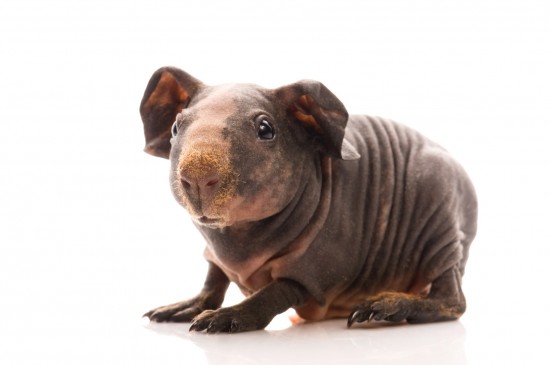

There are some gorgeous little guinea pigs around, some with long silky hair, others with short hair, some cavies boast extraordinary markings and there are even some that have no hair on their bodies at all!
These delightful looking “coat-free” piggies could never be found in the wild because they are the result of experiments carried out in a laboratory. These funny little creatures are in fact, genetic mutations that were first created in 1978 in the laboratories of the Institute Armand Frappier, which is located in Montreal, Canada.
For those people who remember the TV programme called “The Clangers”, these funny hairless cavies look very much like the animated animals that featured in the children's series. Skinnies, as these fur-less guinea pigs are called, have gained a lot of popularity over recent times, although a few words of caution have been published by animal rescue organisations worried about their welfare which is understandable.
Since “skinnies” don't have any fur, except on their noises and a little on their feet, they must be kept indoors in a warm environment. Due to the fact they don't have fur which naturally keeps them warm when the weather is cold, skinnies are prone to catching cold or even hypothermia very easily. You would need to make sure their indoor cages are fun places for them to live in with an area that's cosy and warm so they never feel the cold.
During the hotter summer months, you have to be careful about a skinny pig getting sunburnt. Therefore if you do take them outside, you would need to make sure you put some sun cream on their bodies and face, being extra careful not to get any cream in your pet's eyes.
These funny guinea pigs have become hugely popular with people who cannot otherwise keep pets due to allergies they suffer from which is usually caused when they come into contact with animal fur. More and more people who love animals but who could not be around them due to their allergies, are now the proud owners of skinny pigs, and just like a guinea pig, they make fantastic family pets.
Being such funny, inquisitive little creatures and being so friendly, skinny pigs are making their mark on the animal world with breeders now established in many parts of the country. Because skinnies have to live indoors, they really do become part of a family very much like a cat or a dog. Since they don't have any fur on their bodies, every little detail about them is accentuated and this includes any markings where fur would have grown. However, skinny pigs do have a little fur on their noses and on their feet, but other than in these areas, they are absolutely coat-less right from the moment they are born.
However, skinny pigs have different skin pigmentations which includes the colours chocolate, cinnamon, silver, lilac, white, golden and there are even albino and dalmatian too! These delightful markings consist of black spots on white skin. To date the most popular colour with skinny pig lovers is chocolate.
If you're keen to find out more about skinny pigs, the best place to look is on the Internet where you can find reputable breeders who absolutely adore these adorable little animals that originated in a lab in Canada. You would have to be prepared to set up an indoor cage in a lovely warm area of your home, and make sure your new skinny never, ever gets cold.
The other thing you have to remember is that skinny pigs have higher metabolisms than their hairy brothers and sisters, and therefore they eat a lot more food which means they are more expensive to keep. Lastly, you would have to be prepared to pay well over one hundred pounds for the privilege of owning a skinny pig – and because they are always a lot happier when they have the company of their own kind, you would need to invest in two of the gorgeous little rodents and who wouldn't want to!
Copyright © 2005-2016 Pet Information All Rights Reserved
Contact us: www162date@outlook.com